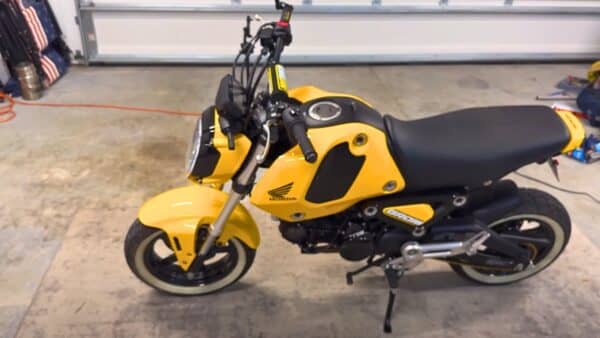The Honda Grom, while offering a blend of compactness and agility, is not without facing its share of problems.

In this article, we will dive into some of the common issues that Grom owners often encounter.
From mechanical glitches to performance-related concerns, we dive into exploring the potential shortcomings of this otherwise admirable motorcycle.
Honda Grom Problems
Users have reported several problems that can affect the riding experience, ranging from mechanical to performance issues.
Some of these problems include a lack of power at high speeds, a tendency to stall, and issues with the fuel injection system.
However, concerns have been raised about the bike’s durability and longevity.
1. Fuel Pump Failure
One of the common problems the owners encounter is fuel pump failure.
This issue can be caused in several ways, such as difficulty starting the bike, poor performance, or an engine that stalls at high speeds.
The fuel pump plays an essential role in supplying a steady flow of fuel from the tank to the engine.
This component must remain in good working condition to ensure optimal bike performance.
Fuel pumps can fail due to dirt, debris, or water entering the pump, leading to damage over time.
Similarly, consistent use of low-quality fuel can also contribute to premature fuel pump failure.
To diagnose a failing fuel pump, look out for signs like an engine that sputters at high speeds, decreased fuel efficiency, or a bike that won’t start.
2. Too Dim Reflectors
The Grom’s reflectors, particularly at the rear, can sometimes be too dim, compromising visibility in low-light conditions.
This can pose potential safety risks, especially for night riders. The reflectors are designed to enhance the visibility of the motorbike to other road users.
Hence, when they’re too dim, it could lead to situations where other drivers can’t spot the bike easily, increasing the chance of accidents.
An immediate solution is to replace the factory-installed reflectors with aftermarket ones that guarantee higher luminosity.
3. Starting Problem
One common issue that Grom owners encounter is problems with the bike’s starting mechanism.
This can result in the motorcycle refusing to start, starting with difficulty, or even shutting off abruptly shortly after being started.
The problem can be due to different causes. Here’s a detailed guide to help you troubleshoot:
Battery
Always check the battery first. If it is not fully charged or is nearing the end of its lifespan, it may not deliver the necessary power to start your Grom.
Spark Plug
If the battery is working fine, the spark plug might be the culprit. A worn-out or fouled spark plug can prevent the bike from starting. Check for any signs of wear or damage. If necessary, replace it.
Fuel System
Ensure that your Grom’s fuel system is in good working order. A clogged fuel filter or injector can impede fuel supply, causing starting problems.
Starter Motor
If all of the above are in good condition, the issue might be with the starter motor. This is a more complex problem and may require a mechanic.
4. Lack of Power
This problem can result in several ways, such as slower acceleration, difficulty in reaching top speeds, or even power cutting off unexpectedly during a ride.
The root cause of this issue can often be traced back to a few key areas.
Firstly, a dirty or clogged air filter can severely limit the amount of air flowing into the engine, reducing the engine’s performance.
Regularly inspecting and cleaning or replacing your air filter can help resolve this issue.
A faulty spark plug could also cause a lack of speed. If the spark plug becomes corroded or covered in dirt, it may not be able to spark correctly.
If your fuel filter is clogged or your carburettor is dirty, this can reduce the amount of fuel that reaches the engine, leading to a power loss.
It could also be due to low engine compression, which could be caused by a worn-out piston, cylinder, or ring.
5. Not Charging
One common problem encountered by Grom owners is the issue of the bike not charging properly.
This can be due to a number of factors, such as a faulty alternator, a worn-out battery, or issues with the wiring.
To fix the issue, check if the battery is old or has not been maintained properly; it may not hold a charge as it should.
You can test the battery using a voltmeter. If the reading is less than 12.6 volts, the battery likely needs to be replaced.
You should also inspect the alternator, as this component is responsible for generating electrical power and charging the battery while the bike is running.
If the alternator is malfunctioning, it will not supply adequate power to charge the battery.
You can test the alternator by checking the voltage of the battery while the bike is running. It should be between 13.5 and 14.5 volts.
Corroded, damaged, or loose wires can prevent the battery from charging. Look for any visible signs of damage. If you find any, replace or repair the wiring as necessary.
6. Speedo Not Working
The speedo may fail to display the correct speed or, in some cases, may not work at all.
This can be due to a few reasons, such as a faulty speed sensor, issues with wiring or a malfunctioning instrument cluster.
The speed sensor, usually located on the front wheel, is responsible for reading the speed at which the wheel is spinning and sending this information to the speedometer.
To check if this is the issue, you can use a multimeter to test the sensor. If the sensor is faulty, the multimeter will not register any changes when the wheel is spinning.
Wiring issues can also cause the speedometer to stop working. Check if there are any visible signs of wear and tear on the wires connected to the speedometer and speed sensor.
If you see any frayed wires or loose connections, they need to be repaired or replaced.
The problem can also be with the instrument cluster, which houses the speedometer.
If the cluster itself is not working properly, even perfectly functioning sensors and wires won’t be able to display the speed.
7. Hard to Find Neutral
Honda Grom has a common issue that could be a challenge for both seasoned riders and beginners – finding neutral.
Neutral, positioned between the first and second gear, can be notoriously elusive, resulting in the rider frequently overshooting it and ending up in either first or second gear.
Here’s a detailed step-by-step guide on how to successfully find neutral on a Honda Grom:
- The gear pattern on the Honda Grom is 1-N-2-3-4, with neutral being located between the first and second gear.
- When shifting from first to neutral, apply very light upward pressure on the shift lever. Remember, you’re not trying to move a full gear, just a half-step.
- As you ease up on the shift lever, feel for a softer ‘click’ that is distinct from the more pronounced ‘clunk’ of a full gear shift. The soft ‘click’ signifies that you’ve found neutral.
- Once you feel the ‘click’, check the neutral indicator light on your instrument panel. If it’s illuminated, congratulations, you’ve successfully found neutral.
Relate: Is Honda Grom Highway Legal?
8. Stay Running
Some users have reported issues related to the bike’s stalling. This issue, often termed as “stay running”, can be quite inconvenient, particularly during long rides.
It could be due to a poor fuel-air mixture, a failing fuel pump, or an obstructed fuel line.
Here’s a detailed guide to help you troubleshoot and resolve this issue:
- The Honda Grom uses a fuel-injected engine, making it sensitive to the fuel-air mixture.
- Ensure the fuel injector is clean and functioning properly. Use a fuel injector cleaner if necessary.
- The fuel pump plays a crucial role in delivering fuel from the tank to the engine. Listen for any unusual sounds when the key is turned on; it may signal a failing pump.
- Finally, make sure the fuel line is not obstructed or kinked. A restricted fuel line can hinder fuel flow and cause the engine to stall.
9. Clutch Issue
One common issue that users often face is related to the clutch. The clutch is an integral part of the motorcycle that allows the engine to effectively engage and disengage from the drivetrain.
When the clutch fails or malfunctions, it can result in difficulty in shifting, a slipping clutch, or an unusually stiff clutch lever.
If you observe any of these symptoms, it’s advisable to inspect your clutch system as soon as possible.
Start by checking the clutch cable for any signs of wear and tear. The cable should move freely without any hitch or drag. If it’s damaged or frayed, it needs to be replaced.
Next, inspect the clutch lever for any abnormalities. Any extra free play can indicate a problem.
Adjust the clutch lever’s free play according to the manufacturer’s specifications.
If the clutch plates are worn out or warped, they will cause the clutch to slip. In such cases, you’ll need to replace the clutch plates.
You can also consider the common issues with the Honda Trail 125, NC750X, NC700X, 2002 Goldwing & 2017 Africa Twin

Ahtsham Younas is a passionate blogger and content writer. He loves to ride motorcycles and learn the mechanical process behind the motorcycles.
He has been writing articles in the motorcycle industry since 2019 and has learned many things about motorbike niches.


